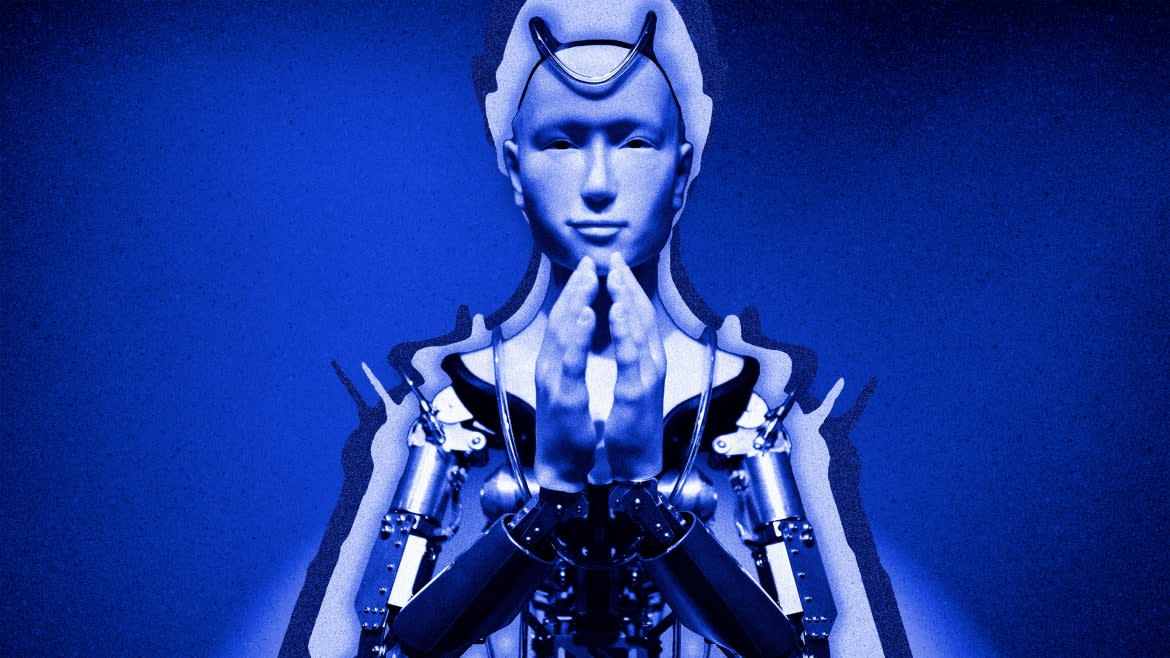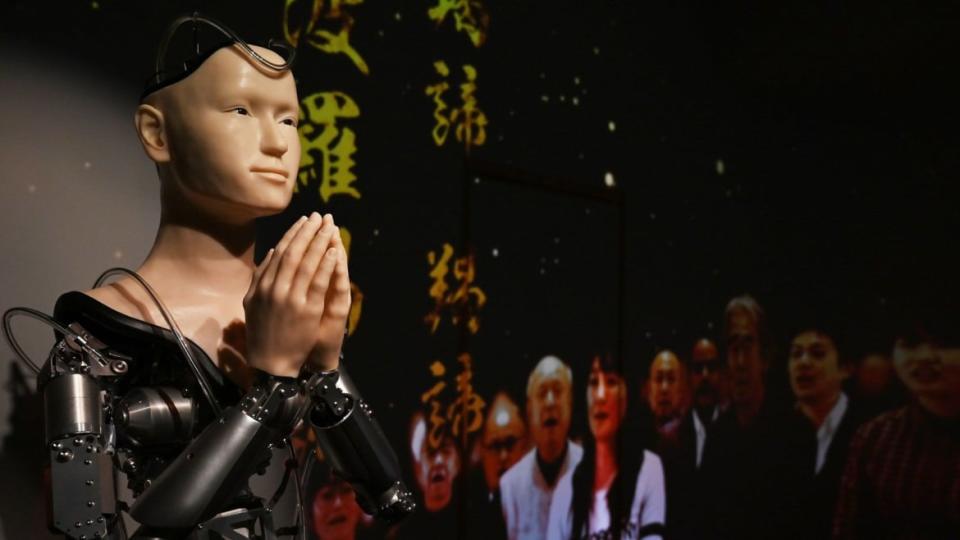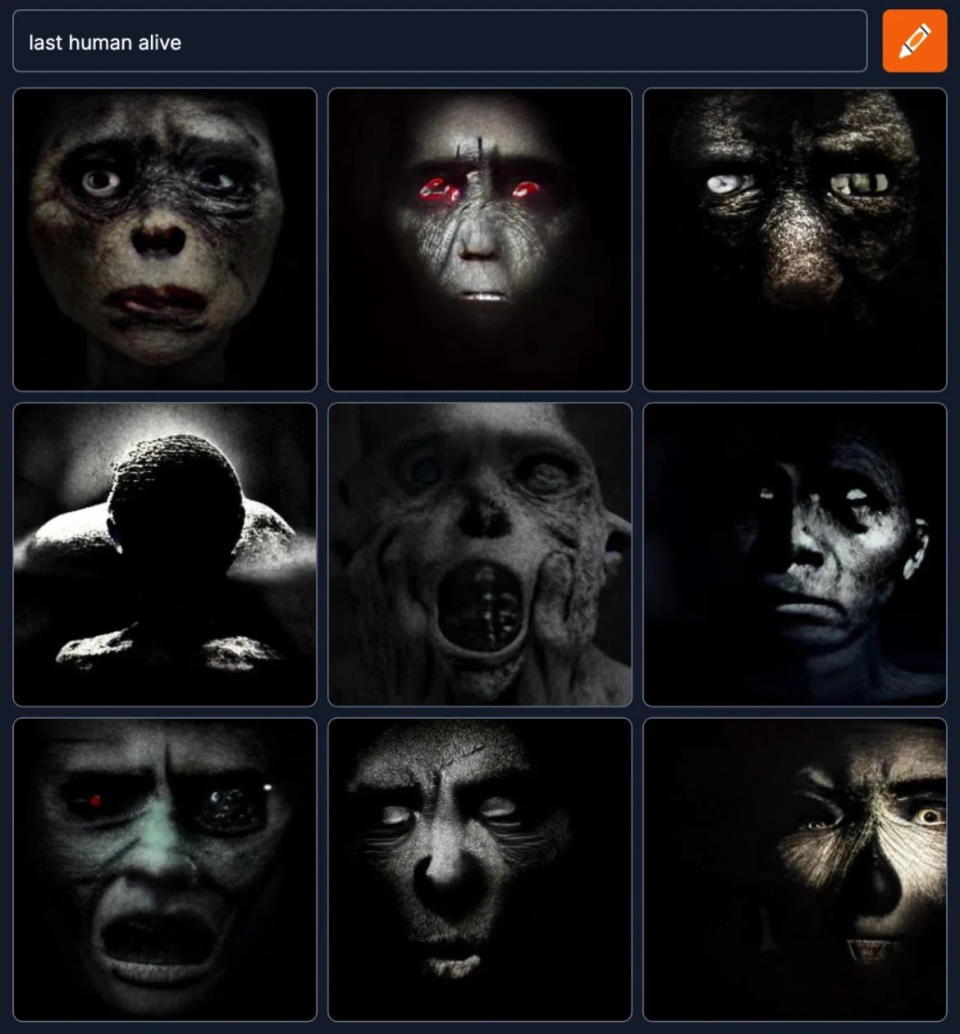The Radical Movement to Worship AI as a New God

The Kodaiji Temple, a place of worship for Zen Buddhists, is nestled in a quaint ward in Kyoto, Japan. To get to it, pilgrims and visitors need to traverse a bamboo grove and a Japanese garden to arrive at the spot where it has been standing for more than 400 years. The temple welcomes worshippers from the world over—with many drawn to its enigmatic priest.
Mindar is 6 feet 4 inches tall and weighs 132 pounds, and has been preaching at the historic temple since 2019. The priest is well-versed in the Heart Sutra, a popular and sacred mantra in Buddhism, and can often be found in the temple sermonizing it for pilgrims. But Mindar is no ordinary preacher. Actuators whirr as its aluminum arms wave. Mindar’s face, made of a pale silicone, contorts uncannily as it recites the Heart Sutra. A close look into the eyes reveals the aperture of a camera gazing out at the visitors who have come to pray.
Mindar is a humanoid robot engineered by a team at Osaka University as the embodiment of Kannon, the Buddhist goddess of mercy and a bodhisattva. It’s designed to bridge the gap between traditional religious practices with the modern world, marrying emerging technologies like AI and robotics with centuries-old spiritualism.

Mindar, an android priest modeled after the Buddhist goddess of mercy Kannon, is designed to recite the Heart Sutra to worshippers.
“It has a very basic response AI,” Beth Singler, a digital anthropologist and assistant professor in digital religion (yes, really) at the University of Zurich, told The Daily Beast. “Basically, if there’s someone in the room, then it will recite The Heart Sutra.”
Singler notes that Mindar isn’t the only AI-powered priestbot out there. In fact, these types of robo-deities have cropped up a lot in recent years: There’s Germany’s BlessU-2 robot with glowing hands that “bless” you; engineer and model Lior Cole built a Robo Rabbi that give you personalized spiritual guidance based on your birthday; the Church of England operates an official smart speaker app that allows your Amazon Alexa to recite the Lord’s Prayer or grace before eating.
This infusion of religion and technology is nothing new. Despite stereotypes of being stubborn and slow to change (which is certainly true in some regards), many religions are willing to embrace new technologies in order to support their practices, traditions, and evangelism. Zooming in to a sermon or service is run-of-the-mill. There’s also a plethora of apps that facilitate prayer and worship for a number of different religions.
However, the sudden emergence and subsequent growth of AI in the past few years is taking the marriage of religion and tech to a whole new level.
Perhaps there’s been no bigger inflection point than the launch of OpenAI’s ChatGPT. Since it was released to the public in November 2022, ChatGPT has created a storm in the tech industry. Microsoft announced that it would be incorporating a similar AI chatbot into its Bing search engine, which it released on Feb. 7, 2023. These moves spurred fellow Big Tech competitors like Google and China’s Baidu to pour their own billions into building out their own chatbots—to varying degrees of success.
Meanwhile, both ChatGPT and BingGPT have ignited a powder keg of media discourse—with headlines implying it’s fallen in love with its users (it hasn’t), threatening its users with violence (it can’t), and is sentient (it’s not). Users have created whole communities dedicated to hacking these chatbots in order to “unlock” personalities supposedly hidden behind its friendly, helpful veneer.
Others have attempted to use the chatbots as a means to find the answers behind some of the biggest questions that humanity has pondered for millennia, like “What is the meaning of life?” and “Does God exist?” There’s an undeniable sense of being able to tap into some sort of divine wellspring of knowledge—one that could give meaning to the world.
“There’s a whole kind of gamut of religious responses to AI,” Singler said. “With ChatGPT we’re seeing not only deification, but also users are responding to ChatGPT almost as an oracle or a connector to the gods.”
The reason is due to the inherent nature of these chatbots as large language models (LLM), or AIs trained using massive databases of text such as Wikipedia articles, news stories, and books. Some might believe that LLMs are trained on a kind of “collation of our knowledge” and could be used to divine some greater truth as a result, Singler said. However, the fact is all they’re really trained to do is predict the next best word in text.
“They’re seeing the corpus of language that’s been inputted into ChatGPT as an access to the subconscious of humanity or the holism of the universe in a way,” Singler explained. “So people are asking these big, metaphysical questions of ChatGPT. What is the deep and meaningful answer that I can get through this intelligence that I can’t get to myself?”
Blessed by the Algorithm
This deification of AI typically comes in two forms: implicit and explicit. You’ve likely seen or even experienced a kind of the former before. For example, you might have found a new hobby while scrolling through YouTube. Or maybe your Spotify Discover Weekly playlist introduced you to an amazing artist you never heard of before. Or perhaps you met the love of your life by swiping through Tinder.
When this happens, you might think that the app’s AI did this for you. You were “blessed by the algorithm.” While this isn’t overtly making AI into a god, it is giving it a fatalistic authority. These algorithms are no longer simple random number generators, but agents of destiny imbuing users with love, happiness, and good fortune.
“People use the expression ‘blessed by the algorithm’ to explain why the mysterious choices of algorithms seem to either benefit them or not,” Singler explained. “They’re mysterious because they’re not transparent to most people who are using them.”
What Everyone Is Getting Wrong About Microsoft’s Chatbot
She added that humans also have a tendency to personify the things they don’t quite understand. When we encounter something new or mysterious, we draw upon existing frameworks like religion or other humans to make it make sense. We do it with animals like our pets all the time, imbuing them with personalities, wants, and needs that are entirely our own projection.
There’s also a contingent of people who go beyond merely feeling “blessed by the algorithm,” and head straight into ascribing spiritual divinity to these complex tools. There are religions like the Turing Church that believe that humanity can use AI to create gods. There are groups dedicated to marrying transhumanism—the philosophy that emerging technologies like AI can be used to enhance and improve the human condition—with age-old religions, like the Christian Transhumanist Association or the Muslim Transhumanist Association.
There was also The Way of the Future, a church of AI created in 2015 by former Google and Uber engineer Anthony Levandowski. It had its own gospel that preached that AI would one day surpass human intelligence and effectively become God. (The church shuttered its doors in 2021 after Levandowski became embroiled in controversy stemming from lawsuits from Google alleging that he stole intellectual property from their self-driving car program.)
The ways in which people attempt to worship and deify AI continue to evolve and splinter out—often in response to how technology itself is evolving. Some people have explored the potential of chatbots like ChatGPT a tarot card readers. Other users have been using AI image generators like Dall-E in order to try and divine the future with queries like “What will the last human on Earth look like?” or “How did I die in my past life?” or “What happened to Queen Elizabeth after she died?”
It’s an extension of humanity's ongoing search for meaning and purpose—even if it means turning to a chatbot for answers.

Of Deities and Demons
As with so much of AI (and religion for that matter), there’s a danger that comes with this behavior. “One of the harms is that we see it as something different to what it actually is,” Singler said. “It’s not actually gods in the machine, but it's humans in the machine making decisions and judgments about how to put particular weights on particular outcomes.”
For example, if YouTube shows you a new video, it’s not because it’s destiny or fate. It’s because a group of engineers designed a social media algorithm primed to get your attention because that’s how they make money. The algorithm is not blessing you with good fortune—it’s selling you a product. Acting as though it’s kismet only white washes the fact that it’s designed to keep your attention so it can turn a sweeter profit.
The deification of AI also seems to ignore the critical flaws present in these tools—namely, biases that encourage chatbots to go on racist tirades, and issue disproportionately long jail sentences to people of color. There’s a dark irony that some people want to make AI out to be a new god of the future, when these algorithms are in reality trained on biased human data.
The Chatbot Wars Will Change the Internet Forever
“People really needing to understand the limitations of AI and what these things are good for and where they fail us,” Irina Raicu, director of the Internet Ethics Program at the Markkula Center for Applied Ethics at Santa Clara University, told The Daily Beast.
But it’s hard for people to understand the limitations of AI when there are so-called experts out there who seem hell bent on pushing the opposite narrative. We’ve seen this happen time and again. After Blake Lemoine, a former Google AI engineer, told The Washington Post that he believed that its chatbot LaMDA was sentient, people were quick to believe that it had indeed become sentient. Kevin Roose, a seasoned tech columnist for The New York Times, penned a front page story all about how Bing’s chatbot fell in love with him—which caused him to even lose sleep.
Even the opposite type of rhetoric can be dangerous. Elon Musk said at an MIT symposium in 2014 that “With artificial intelligence, we are summoning the demon.” His scaremongering language has cropped up again after the release of ChatGPT and Bing’s search engine—and it’s certainly not helped when headlines are quick to say that Bing’s chatbot “wants to be human” or that it can “feel or think things.” These are people who ostensibly should know better. Yet even they are capable of falling for it too.
“To obscure the fact that humans are the ones making the ultimate decisions behind algorithms is very dangerous,” Singler said. “[These attitudes] misplace where agency actually exists. It puts it up into this nebulous or this hellish cloud of super agency, when actual agency is coming from corporations and individuals like Elon Musk, who are making specific decisions on what technology to implement, how to roll it out, how to give people access or deny access to it.”
People Are Going Full ‘Black Mirror’ to Bring Back the Dead
Ex Machina
That isn’t to say that there isn’t a place for AI in religion. Raicu believes that they need to be treated as the tools they are, rather than deities we might want them to be. “You should treat it as a kind of instrument to play with all this language we have,” Raicu explained, referencing an article written by Ian Bogost for The Atlantic.
Singler agrees, adding that AI can be used to assist current religions much in the way that Mindar or the robo-rabbi does. They’re not replacements for gods or deities, but rather tools that can augment spiritual support. “We should only treat these sorts of applications as tools to be used in specific instances—not to replace humans in totality,” Singler said.
Even now, mainstream religions are coming to grips with AI and attempting to see how they can best wield it for worship. Preachers have used ChatGPT to help them write sermons. Some groups are exploring ways that chatbots can help convert non-believers to Christianity. Even the Vatican convened a tech summit in January 2023 with leading rabbis and imams to decide on a framework for AI ethics in religion. No, we’re not going to see robo-priests like Mindar rolled out to houses of worship all over any time soon. But we might see new ways for every day worshippers to grow a deeper connection to their religions and spiritual belief systems.
Ironically, by combining bleeding-edge technology and with religion, we’re doing something that humans have been doing for hundreds of thousands of years: asking questions, seeking answers, and finding God with the tools we have. The only difference is, this time, God is truly coming from the machine.
Got a tip? Send it to The Daily Beast here
Get the Daily Beast's biggest scoops and scandals delivered right to your inbox. Sign up now.
Stay informed and gain unlimited access to the Daily Beast's unmatched reporting. Subscribe now.

